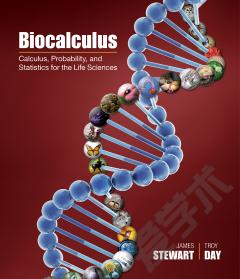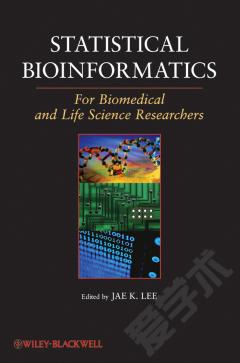Biocalculus —— Calculus, Probability, and Statistics for the Life Sciences
----- 生物微积分
PROLOGUE: MATHEMATICS AND BIOLOGY. CASE STUDIES. Case Study 1: Kill curves and antibiotic effectiveness. Case Study 2: Hosts, parasites, and time travel. Chapter 1 Functions and Sequences. 1.1 Four Ways to Represent a Function. 1.2 A Catalog of Essential Functions. 1.3 New Functions from Old Functions. Project: The Biomechanics of Human Movement. 1.4 Exponential Functions. 1.5 Logarithms Semi-log and Log-log Plots. Project: The Coding Function of DNA. 1.6 Sequences and Difference Equations. Project: Drug Resistance in Malaria. Review. Case Study 1a: Kill curves and antibiotic effectiveness. Chapter 2 Limits. 2.1 Limits of Sequences. Project: Modeling the Dynamics of Viral Infections. 2.2 Limits of Functions at Infinity. 2.3 Limits of Functions at Finite Numbers. 2.4 Limits: Algebraic Methods. 2.5 Continuity. Review. Case Study 2a: Hosts, parasites, and time travel. Chapter 3 Derivatives. 3.1 Derivatives and Rates of Change. 3.2 The Derivative as a Function. 3.3 Basic Differentiation Formulas. 3.4 The Product and Quotient Rules. 3.5 The Chain Rule. 3.6 Exponential Growth and Decay. Project: Controlling Red Blood Cell Loss During Surgery. 3.7 Derivatives of the Logarithmic and Inverse Tangent Functions. 3.8 Linear Approximations and Taylor Polynomials. Project: Harvesting Renewable Resources. Review. Case Study 1b: Kill curves and antibiotic effectiveness. Chapter 4 Applications of Derivatives. 4.1 Maximum and Minimum Values. Project: The Calculus of Rainbows. 4.2 How Derivatives Affect the Shape of a Graph. 4.3 L"Hopital"s Rule: Comparing Rates of Growth. Project: Mutation-Selection Balance in Genetic Diseases. 4.4 Optimization. Project: Flapping and Gliding. Project: The Tragedy of the Commons: An Introduction to Game Theory. 4.5 Recursions: Equilibria and Stability. 4.6 Antiderivatives. Review. Chapter 5 Integrals. 5.1 Areas, Distances, and Pathogenesis. 5.2 The Definite Integral. 5.3 The Fundamental Theorem of Calculus. Project: The Outbreak Size of an Infectious Disease. 5.4 The Substitution Rule. 5.5 Integration by Parts. 5.6 Partial Fractions. 5.7 Integration Using Tables and Computer Algebra Systems. 5.8 Improper Integrals. Project: Drug Bioavailability. Review. Case Study 1c: Kill curves and antibiotic effectiveness. Chapter 6 Applications of Integrals. 6.1 Areas Between Curves. Project: Disease Progression and Immunity. Project: The Gini Index. 6.2 Average Values. 6.3 Further Applications to Biology. 6.4 Volumes. Review. Case Study 1d: Kill curves and antibiotic effectiveness. Case Study 2b: Hosts, parasites, and time travel. Chapter 7 Differential Equations. 7.1 Modeling with Differential Equations. Project: Chaotic Blowflies and the Dynamics of Populations. 7.2 Phase Plots, Equilibria, and Stability. Project: Catastrophic Population Collapse: An Introduction to Bifurcation Theory. 7.3 Direction Fields and Euler"s Method. 7.4 Separable Equations. Project: Why Does Urea Concentration Rebound After Dialysis? 7.5 Systems of Differential Equations. Project: The Flight Path of Hunting Raptors. 7.6 Phase Plane Analysis. Project: Determining the Critical Vaccination Coverage. Review. Case Study 2c: Hosts, parasites, and time travel. Chapter 8 Vectors and Matrix Models. 8.1 Coordinate Systems. 8.2 Vectors. 8.3 The Dot Product. Project: Microarray Analysis of Genome Expression. Project: Vaccine Escape. 8.4 Matrix Algebra. 8.5 Matrices and the Dynamics of Vectors. 8.6 The Inverse and Determinant of a Matrix. Project: Cubic Splines. 8.7 Eigenvalues and Eigenvectors. 8.8 Iterated Linear Transformations. Project: The Emergence of Geometric Order in Proliferating Cells. Review. Chapter 9 Multivariable Calculus. 9.1 Functions of Several Variables. 9.2 Partial Derivatives. 9.3 Tangent Planes and Linear Approximations. 9.4 The Chain Rule. 9.5 Directional Derivatives and the Gradient Vector. 9.6 Maximum and Minimum Values. Review. Chapter 10 Systems of Linear Differential Equations. 10.1 Qualitative Analysis of Linear Systems. 10.2 Solving Linear Systems of Differential Equations. 10.3 Applications. Project: Pharmacokinetics of Antimicrobial Dosing 10.4 Systems of Nonlinear Differential Equations. Review. Case Study 2d: Hosts, parasites, and time travel. Chapter 11 Descriptive Statistics. 11.1 Numerical Descriptions of Data. 11.2 Graphical Descriptions of Data. 11.3 Relationships Between Variables. 11.4 Populations, Samples, and Inference. Review. Chapter 12 Probability. 12.1 Principles of Counting. 12.2 What is Probability? 12.3 Conditional Probability. Project: Testing for Rare Diseases. 12.4 Discrete Random Variables. Project: DNA Supercoiling. Project: The Probability of an Avian Influenza Pandemic in Humans. 12.5 Continuous Random Variables. Review. Chapter 13 Inferential Statistics. 13.1 The Sampling Distribution. 13.2 Confidence Intervals. 13.3 Hypothesis Testing. 13.4 Contingency Table Analysis. Review. Appendixes. A Intervals, Inequalities, and Absolute Values. B Coordinate Geometry. C Trigonometry. D Precise Definitions of Limits. E A Few Proofs. F Sigma Notation. G Complex Numbers. H Sttistical Tables. I Glossary of Biological Terms. J Answers to Odd-Numbered Exercises. List of Biological Applications. Index.
{{comment.content}}








 京公网安备 11010802027623号
京公网安备 11010802027623号